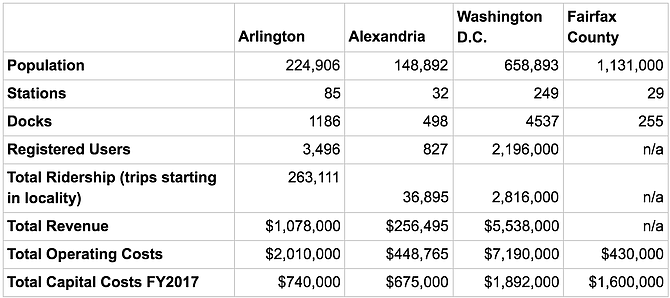It takes a little over two hours to bike from downtown Washington D.C. to the Reston. For the Capital Bikeshare, it’s a trip that’s taken six years.
On Oct. 21, Fairfax County launched 29 bike-share stations in Reston and Tysons, joining Alexandria and Arlington in the expansion of Capital Bikeshare into Northern Virginia.
While the program doesn’t recover all of its costs, experts say it’s highly unusual for any public transportation.
“In general, as transport researcher, no transport mode covers its costs,” said Ralph Buehler, an associate professor in Urban Affairs at Virginia Tech’s Alexandria Campus. “Public transport is highly subsidized in terms of operating and building infrastructure. If you think about automobiles and the gas tax, and what it covers in terms of roadways, it’s only about 60 percent nationally. All transport is subsidized.”
Buehler says there are a number of different ways each locality can measure success. For Leah Brooks, a professor of public policy and administration at George Washington University, the best measure was how bike-share programs measure up to other transit systems, like bus or metro. Arlington has a 54 percent cost recovery, meaning the bike share recovers a little over half of what is spent on the program. In Washington D.C., Capital Bikeshare has a 75 percent cost recovery ratio for 2016 and is projected to increase to 87 percent by FY2021. According to Carrie Sanders, deputy director of Alexandria’s Transportation and Environmental Services, the city’s bike-share recovers 62 percent of its operating costs. Measured by cost recovery, Capital Bikeshare in Arlington and Alexandria are not as successful as Metrorail, which recovers 71 percent of its costs, but are more successful than bus programs like Metrobus and ART bus, or DASH bus which each recover roughly 30 percent of their cost.
But as the bike-share expands in Northern Virginia, that success could be compromised as more and more stations are located outside of Metro and tourist centers. In Arlington, ridership is still increasing but at a slower rate each year. Ridership doubled in fiscal year (FY) 2012 and increased by 75 percent in FY 2013, between 2014 and 2015 ridership increased by 18 percent. As the system expands, the average number of trips per bicycle has also decreased from 393 to 381.
“This decrease was expected as the system expands to outside of Arlington’s Metrorail corridors where the highest ridership stations are located,” said Arlington County staff in a 2015 progress report on the Capital Bikeshare. “Moving forward, the system will likely see a slowing of ridership growth as the service matures.”
Experts say that as the bike-share moves further away from Metro stations, the less cost effective the program becomes.
“The system lives and dies by its opportunities to pick up and drop off a bike,” said Buehler “If the network of stations is spread too thinly, people won’t use it. In Montreal, most bike-shares are concentrated in the most dense urban area. It’s around just two blocks. The D.C. system is a little more spread out, but if you spread them too thinly, you lose the utility of the system. They have to be careful as they go out into the suburbs. You have to give riders actual options for 30-minute rides. Spreading out can be a good thing, but too few stations in an area will hurt the system. The ones in Tysons and Reston are locally concentrated, which seems like the right way to do it.”
Like Arlington, Capital Bikeshare in Alexandria has been centered around metro stations. The most popular bikeshare station is the dock outside the Braddock Street Metro with a total 7,827 trips departing from that station in 2015. The King Street Metro station was the second most popular, with 6,194 trips.
Like Arlington, as the system expands, the plans for Capital Bikeshare expansion will push the bike-share further from the Metro and the dense population centers. However, Sanders said Alexandria will continue to focus its bike-share expansion around other major public transportation projects.
“As we expand, we’re looking to continue to have bike-share stations be close to activity centers like bus rapid transit stations,” said Sanders.
“As we add to the network opportunities we’ll see ridership continue to increase and we’ll see it become more convenient for people,” said Yon Lambert, director of Transportation for Alexandria. “People will see that it can be more convenient, quicker and safer.”
Brooks also emphasized that Capital Bikeshare’s current success is largely a result of the program’s ability to integrate with other forms of public transit.
“The key thing with the bike-share is where the stations are located,” said Brooks. “That means are they near people that want to ride them and near locations that mesh with transit.”
In some ways, Brooks says bike-share in Northern Virginia is more comparable to the Citi-Bike system in New York than to the bike-share in Washington D.C. According to Brooks, Capital Bikeshare’s success in D.C. benefits from high numbers of tourists, who pay a high upfront fee to ride and don’t ride it as much as residents do. In New York, Brooks says most of the riders are riders are residents using the system to get to and from subway stations. While areas like Old Town Alexandria and Rosslyn might see similar benefits from tourist use, as the bikeshare expands further away from tourist centers Brooks says the ridership will largely shift towards the more costly role of supplementing local resident transit.
According to Buehler, localities like Fairfax, Alexandria, and Arlington continue to push for bikeshare stations to create a more modernized image in an effort to attract more development.
“There is a sense among developers and city officials, maybe even among residents, that having a bikeshare system makes you a cutting edge place to be,” said Buehler. “It’s part of the image. If Arlington County or Alexandria wants to attract residents or businesses, they point to the Metro, to waterfront, and to the Torpedo Factory. Now, they can point to Capital Bikeshare.”

